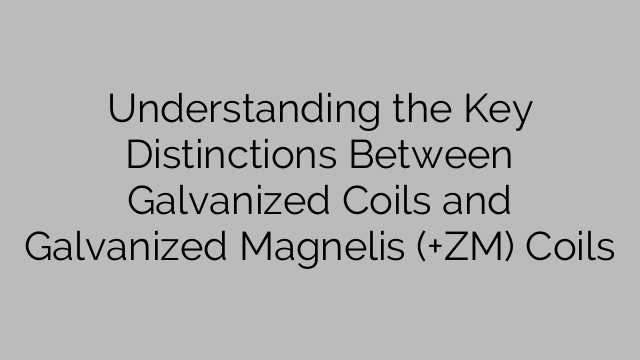Galvanized steel is a popular material used in various industries due to its exceptional corrosion resistance. There are two main types of galvanized coatings used to protect steel from rust and corrosion: traditional galvanized coatings and innovative Galvanized Magnelis (+ZM) coatings. Both options offer significant benefits for different applications, and it is essential to understand the key distinctions between the two.
Traditional galvanized coatings are made by applying a layer of zinc to the steel substrate through a hot-dip process. This process forms a thin, tight bond between the zinc and the steel, providing an effective barrier against corrosion. Galvanized coils are commonly used in construction, automotive, and industrial applications for their durability and protection against rust.
On the other hand, Galvanized Magnelis (+ZM) coatings are a more recent innovation in the galvanizing industry. This new coating is a zinc-aluminum-magnesium alloy, offering enhanced corrosion protection compared to traditional galvanized coatings. The addition of magnesium provides increased protection in harsh environments, making it suitable for outdoor applications, coastal regions, and industrial environments with high humidity and chemical exposure.
One of the key distinctions between traditional galvanized coils and Galvanized Magnelis (+ZM) coils is the level of corrosion resistance. While traditional galvanized coatings provide reliable protection in most environments, Galvanized Magnelis (+ZM) coatings offer superior performance in more aggressive conditions. This can result in longer-lasting and more reliable protection for steel structures and components, especially in challenging industrial and marine applications.
Additionally, Galvanized Magnelis (+ZM) coatings offer improved cut-edge protection, making them ideal for applications where the edges of the steel are exposed to potential corrosion. This enhanced protection ensures that the entire surface of the steel is safeguarded from rust and deterioration, extending the lifespan of the material and reducing the need for maintenance and repairs.
Another important distinction is the appearance of the two coatings. Traditional galvanized coatings have a bright, shiny finish, while Galvanized Magnelis (+ZM) coatings have a matt grey appearance. The difference in appearance may be a consideration for certain applications where aesthetics are important.
In terms of cost, Galvanized Magnelis (+ZM) coatings may be slightly more expensive than traditional galvanized coatings due to the additional materials and technology required for production. However, the superior corrosion resistance and extended lifespan of Galvanized Magnelis (+ZM) coatings may ultimately result in cost savings by reducing the need for maintenance, repairs, and premature replacement of steel components.
In conclusion, understanding the key distinctions between galvanized coils and Galvanized Magnelis (+ZM) coils is crucial for selecting the most suitable coating for specific applications. Traditional galvanized coatings provide reliable protection in standard environments, while Galvanized Magnelis (+ZM) coatings offer enhanced corrosion resistance and longevity, making them ideal for harsh conditions. By evaluating the performance, appearance, and cost considerations, businesses can make informed decisions about which coating option best meets their needs for long-term protection and durability.

